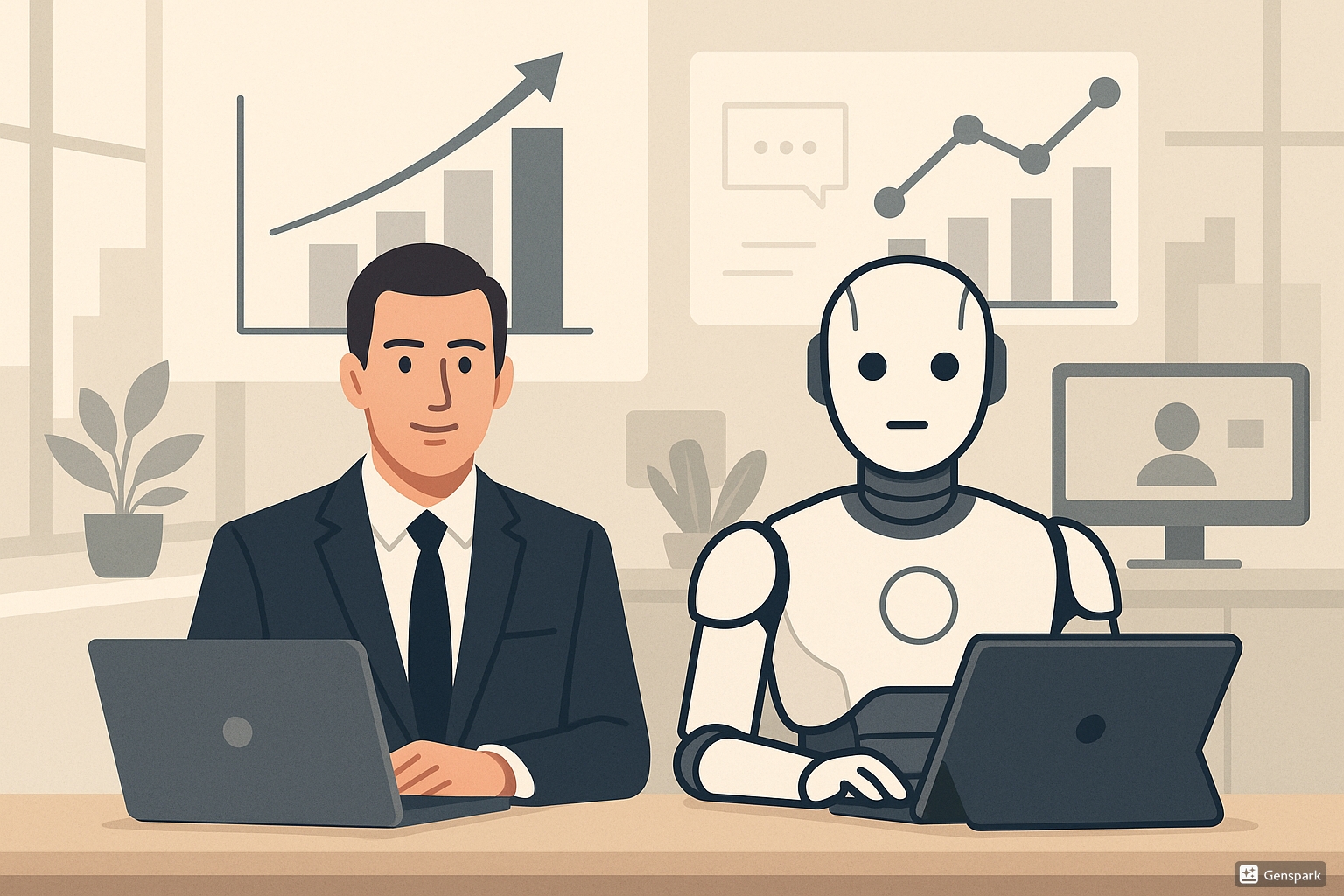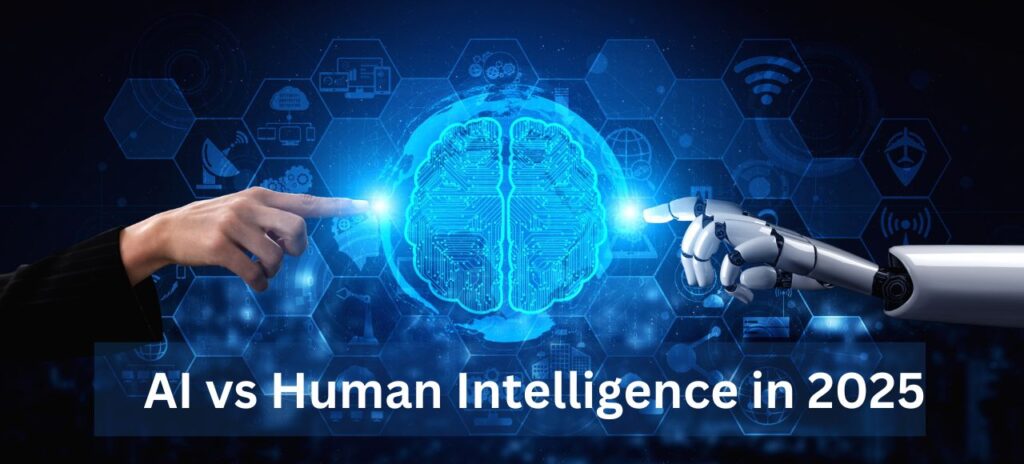Published on May 3, 2025 • 12 min read

Table of Contents
- Introduction
- The Numbers: AI Productivity Statistics
- Where AI Excels: Tasks Worth Automating
- Where Humans Shine: Tasks Best Left to People
- Decision Framework: What to Automate?
- Real-World Implementation Cases
- Future of AI-Human Collaboration
- Conclusion
The New Workplace Paradigm: Humans and AI
The contemporary workplace is experiencing a major overhaul. AI has shifted from a futuristic fantasy to a ubiquitous tool that’s changing the way we work. As companies rush to bring A.I. to the market, a counter-trend has been silently gathering momentum: that of anti-A.I. If the ethos of A.I. development is to automate processes for the sake of efficiency, the thinking goes, then it is even more efficient not to automate some things: More than efficiency, it is about propriety to let a human handle certain things.
It’s not just a matter of substituting human workers with machines, it’s about redesigning the whole ecosystem of work so as to exploit the unique capabilities of both humans and machines. “Humans are good at subtasks that involve situational or emotional understanding; AI is good at the reverse,” according to Sloan’s Automatic For The People: How Enterprise Uses AI And ML report.
In this deep-dive guide, we’ll consider the most recent evidence for AI productivity increases, decide which tasks are best for automation and which are best left in human hands, and establish a useful framework for identifying smart automation choices that create real business value.
The Numbers: AI Productivity Statistics
To understand the impact of AI on productivity, let’s look at what the data tells us:
Key AI Productivity Statistics
- 40% Performance Boost: Generative AI can improve a highly skilled worker’s performance by nearly 40% compared to workers not using AI tools (MIT Sloan, 2023)
- 66% Productivity Increase: On average, business users experienced a 66% increase in throughput when using generative AI tools for realistic tasks (Nielsen Norman Group, 2023)
- 5.4% Time at work saved: Workers reported that using AI to produce creative work had saved them 5.4% of their service week, or a 1.1% increase in sectoral productivity (St. Louis Fed, 2025).
- 0.1% to 0.6% growth per annum: Generative AI might foster labor productivity growth of some 0.1 to 0.6 percent annually up to 2040, depending on adoption rates (McKinsey, 2023)
- $4.4T Opportunity: McKinsey reports long-term AI economic impact estimated at $4 trillion to $4.4 trillion based on added productivity growth potential from corporate use-cases
But these impressive numbers don’t tell the full story. Though AI certainly provides huge productivity increases, those gains are not universal for a given task or job. We need to do, in order to fully realize the potential of AI: understand where it genuinely adds value—and where human capabilities remain superior.

Where AI Excels: Tasks Worth Automating
AI demonstrates clear advantages in specific types of tasks. Identifying these areas is the first step in determining what’s worth automating:
1. Data Processing and Analysis
AI systems have the capability to analyze enormous volumes of data at speeds humans never could, discovering patterns, outliers and insights without human fatigue. AI automation is perfect for tasks that involve enormous data sets, number crunching, or statistics.
Examples: Financial modeling, market trend analysis, research paper reviews, product pricing optimization, and customer behavior pattern identification.
2. Repetitive and Rule-Based Tasks
Any sort of repetitive job which follows somewhat of a pattern or paradigm here, is great for AI automation. These sorts of duties can suck human energy and attention and return very little creative joy.
Examples include: Data entry, report preparation, slide preparation, calendar management, filing, travel scheduling, simple customer queries.
3. Content Generation and Enhancement
AI has become remarkably capable at generating and enhancing content across various formats, providing valuable starting points that humans can refine.
Examples: First drafts of reports, email templates, product descriptions, code snippets, presentation outlines, and social media post generation.
4. Testing and Quality Assurance
AI can systematically test systems, products, or content with greater consistency and coverage than manual testing allows.
Examples: Software testing, proofreading documents, checking data accuracy, validating website functionality, and verifying compliance with standards.
5. Personalization at Scale
AI is great at personalizing experiences for many users simultaneously, a task that would be difficult to accomplish manually.
For instance, content recommendationss, customized marketing messages, price dynamically, personalized learning experiences, and UI customization.
Where Humans Shine: Tasks Best Left to People
Despite AI’s impressive capabilities, many tasks remain better suited to human expertise and intuition:
1. Creative Innovation and Original Thinking
And although AI can produce variations on a theme, it takes a human to have a truly new idea or a creative breakthrough. As one study conducted at the Massachusetts Institute of Technology concluded, “even the best human still outperforms any current artificial intelligence in creative divergent thinking tasks.”
Examples: Ground-breaking product design, Creative development of new strategy, Artistic, artistic expression, and novel problem-solving approaches.
2. Emotional Intelligence and Relationship Building
Jobs that involve real empathy, emotional depth or relationship building are not helped by humans, this not something we can feign, and this is not something where we want a synthetic response.
Examples: Difficult customer service scenarios, coaching, counseling, negotiation, conflict resolution, and leadership by a formal team lead.
3. Ethical Decision-Making and Value Judgments
Decisions that require human intuition, judgment and juggling competing values are beyond the scope of what AI fundamentally has to offer.
Examples: HRs decisions affecting people´s careers, ethical dilemmas, strategy lifetime, and social consequential decisions.
4. CONTEXT AWARENESS IN UNSTRUCTURED ENVIRONMENTS
People are good at interpreting ambiguity, reading between the lines, and understanding nuance given context when presented with complex, unstructured, or new scenarios.
Examples: Handling crises, decoding indirect advice, understanding social dynamics and quickly responding to changes in the environment.
5. Cross-Domain Integration and Systems Thinking
Weare still far superior to computers at synthesising knowledge across different domains, making connections across dissimilar fields, and perceiving wholesystems.
Examples: Interdisciplinary research, visioning strategy, complex organizational problem solving, recognizing unexpected connections or opportunities.
Decision Framework: What to Automate?
When deciding which tasks to automate with AI versus keep in human hands, consider this practical framework:
| Factor | Favors AI Automation | Favors Human Execution |
|---|---|---|
| Task Frequency | High frequency, repetitive | Low frequency, unique |
| Pattern Recognition | Clear patterns, structured data | Ambiguous patterns, unstructured data |
| Creativity Required | Low originality, formula-based | High originality, novel thinking |
| Emotional Intelligence | Minimal emotional context | High emotional intelligence needed |
| Stakes of Decisions | Low-risk decisions | High-risk, ethical implications |
| Data Volume | Large data processing needed | Minimal data processing |
| Speed Requirement | Quick response essential | Thoughtful deliberation valuable |
| Variability | Consistent environment | Highly variable conditions |
Questions to Ask Before Automating
- 1. Does this task require genuine creativity or novel problem-solving?
- 2. Does successful execution depend on emotional intelligence or relationship building?
- 3. Would automation risks outweigh efficiency benefits?
- 4. Could AI assist humans rather than replace them entirely for this task?
- 5. What’s the cost-benefit ratio of automation versus human execution?
Real-World Implementation Cases
Case Study 1: Customer Service Optimization
Company: Enterprise SaaS Provider
Approach: Implemented AI chatbots for common customer queries while routing complex issues to human representatives.
Results: 14% increase in overall productivity as measured by resolved issues per hour. Customer satisfaction maintained as humans focused on high-value interactions while AI handled routine questions.
Key Lesson: Hybrid approaches often deliver better results than complete automation or purely manual processes.
Case Study 2: Content Marketing Team
Company: Digital Marketing Agency
Approach: Used AI for content research, outlines, and first drafts; humans for strategic direction, voice refinement, and final editing.
Results: Content production increased by 64% while maintaining quality metrics. Team shifted focus to strategy and client relationships.
Key Lesson: AI works best as an amplifier of human creativity rather than a replacement.
Case Study 3: Financial Analysis
Company: Investment Management Firm
Approach: AI systems process market data and generate preliminary insights; human analysts focus on interpretation, contextual factors, and client-specific recommendations.
Results: Analysts can serve 30% more clients with more personalized advice. Decision quality improved through complementary strengths.
Key Lesson: The highest value often comes from combining AI’s data processing with human judgment and relationship skills.

Future of AI-Human Collaboration
The future of work is not robots replacing humans, it is human-robot collaboration at its best. Here’s what’s emerging:
1. AI as Cognitive Assistants
Rather than complete automation, we’re seeing the rise of AI systems that function as cognitive assistants—enhancing human capabilities by handling specific subtasks while humans maintain overall control and direction.
2. Continuous Learning Partnerships
The relationship between humans and AI is evolving into continuous learning partnerships where AI systems learn from human expertise while humans leverage AI insights to develop new skills and approaches.
3. Shifting Human Focus
And as AI replaces menial and computational work, human jobs are being redefined to favour uniquely human strengths—intuitive, empathetic, ethical, and cross-disciplinary thinking.
“The right way to think about it is to say it’s not humans or AI, it’s humans and AI, working together to do something better than we could do alone,” he said. – McKinsey Digital, 2025
4. Emergence of New Roles
The AI revolution is creating entirely new job categories focused on human-AI collaboration: prompt engineers, AI trainers, automation ethicists, and AI-augmented creative professionals.
In conclusion: Executing at the Right Value.
The choice isn’t if to embrace AI, but how to thoughtfully integrate it to best realize — and retain — the humanity that distinguishes your business.
The best performing organizations carefully map their tasks and processes such that they know where AI can add truly productivity gains and where human expertise is still required for conceptual reasoning. This is not a one-time exercise, but an ongoing evolution as AI capabilities continue to expand and business requirements change.
Remember these key principles:
- Automate repetitive, data-heavy tasks where patterns are clear
- Augment human capabilities in areas requiring judgment and creativity
- Preserve fully human execution for tasks involving emotional intelligence and ethical complexity
- Focus on creating workflows where AI and humans complement each other
- Continuously reassess as AI capabilities evolve
By thoughtfully implementing AI for appropriate tasks while leveraging uniquely human capabilities where they add the most value, organizations can achieve the 40% productivity gains promised by research while creating more engaging, meaningful work for their people.
Ready to optimize your AI-human workflow?
Start by mapping your team’s tasks using our framework to identify your highest-value automation opportunities.Download Task Assessment Template
Related Articles
How to Choose the Right AI Tools for Your Team
A comprehensive guide to evaluating and selecting AI solutions that deliver real business value.
The Human Skills That AI Can’t Replace
Developing the capabilities that will remain uniquely valuable in an AI-powered workplace.
Measuring ROI on AI Implementation
Key metrics and frameworks for evaluating the business impact of your AI investments.
Training Your Team for AI Collaboration
Essential skills and mindsets for employees working alongside AI systems.
You can also visit our Other blogs : luxira.in



